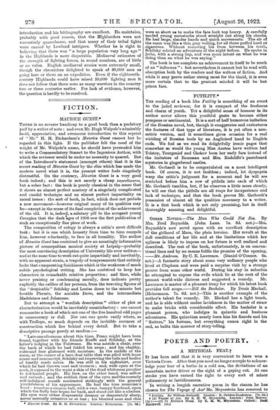CLAN WARFARE IN THE HIGHLANDS.
Ma. Dawn N. MACKAY has described in a singularly interesting book, Clan Warfare in the Scottish Highlands (Paisley : Alexander Gardner, 7s. 6d. net), a dozen of the numerous clan fights which have been recorded, from the conflict between Munro and Mackintosh at Clachnahany in 1454 down to the encounter of the Mackintoshes at Mulroy in 1688 with the MacDonalds, led by "Coil of the Cows." The cruel episode at Eigg, about the year 1677, when two hundred MaeDonalds were stifled in a cave by the MacLeods, and the still more brutal massacre of the Laments at Dunoon in 1646 by the Campbells, are fairly well known ; the other chapters will be new to most Southern readers. Mr. Mackay is justified in giving an imagina- tive setting to some of the incidents. He is well versed in High- land history but, as he honestly admits, much of it is based on traditions, committed to writing long after the events, and not much more trustworthy as a record than the Iliad or the Song of Roland. In the main the stories are true, but the details vary according to the bias of the clan chronicler. Mr. Mackay's
introduction and his bibliography are excellent. He maintains, probably with good reason, that the Highlanders were not excessively quarrelsome, and that many of their tribal fights were caused by Lowland intrigues. Whether he is right in believing that there was "a large population very long ago" in the Highlands is more disputable. Mediaeval estimates of the strength of fighting forces, in round numbers, are of little or no value. English mediaeval armies were extremely small, though the chroniclers delighted to speak of 60,000 men as going here or there on an expedition. Even it the eighteenth- century Highlands could have raised 50,000 fighting men it does not follow that there were as many warriors in the country two or three centuries earlier. For lack of evidence, however, the question is hardly to be resolved.



































 Previous page
Previous page